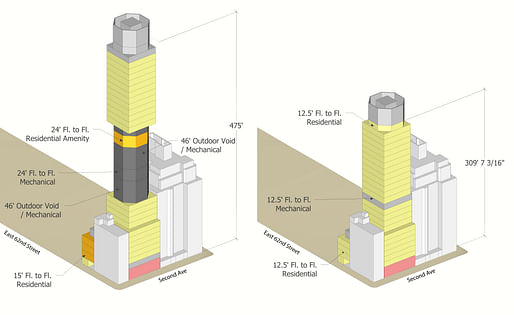

"It is difficult enough for Firefighters operating inside of high-rise buildings. Access to the fire area and to whatever is on fire is paramount to save lives and to protect Firefighters operating at these fires... While we acknowledge and accept the risks of our profession, we strongly oppose construction methods that are inherently dangerous that for no valid reason increase the threat to the lives of the public and our members." — Uniformed Firefighters Association of Greater New York
The Uniformed Firefighters Association of Greater New York has come out in strong support of state-level legislation aimed at limiting the ability of real estate developers to use "mechanical void spaces" to game zoning codes into allowing them to construct taller buildings.
In a strongly-worded memo, circulated by the Friends of the Upper East Side Historic Districts group, the Fire Department of New York union says, "Void spaces, often entire floors in buildings put hazardous equipment such as High Voltage Air Conditioning and heating equipment in the middle of buildings, many floors above street level. These void floors bring fire hazards into areas of a building where it is most difficult for Firefighters to fight these types of equipment fires."
Two legislative proposals, Senate Bill S3820A and Assembly Bill A5026A, aim to fine-tune how municipalities define a project's floor area.
Under recent guidelines in New York City, for example, spaces that contain mechanical units and other building infrastructure elements are not counted toward the allowable floor area total for given sites. This loophole has been exploited by developers and architects to stretch their buildings skyward, creating massive, uninhabited voids in the midsections of several of Manhattan's tallest towers. The added height boosts the market value of upper floor residential units, which, because of their elevated position, can now command superior views.
The phenomenon has led to what some call an "accidental skyline," especially along the southern edge of Central Park.
The two bills are currently making their way through the legislative process. The New York City council recently passed a similar measure in May.
2 Comments
they should also make developers responsible for this bs go back and take out the unnecessary floors or put in affordable units on those floors
For comparison- Chinese building codes specify allowable floor to floor heights based on building usage (office, residential, performance, etc). We often run into problems that MEP equipment exceeds the allowable FF height, so the owner ends up using 2 floors of FAR to build a single floor of MEP. not a solution likely to pass in NY.
I disagree with part of the FDNY statement though. There are legitimate reasons to put MEP in mid floor spaces and this is standard practice even where towers are not exploiting any loopholes. The alternative would often be to locate equipment on the roof, which doesn't seem helpful to firefighters.
a better remedy would be to develop planning based on FAR that provided reasonable height limits. there would be no reason to create void space if height was limited.
Block this user
Are you sure you want to block this user and hide all related comments throughout the site?
Archinect
This is your first comment on Archinect. Your comment will be visible once approved.